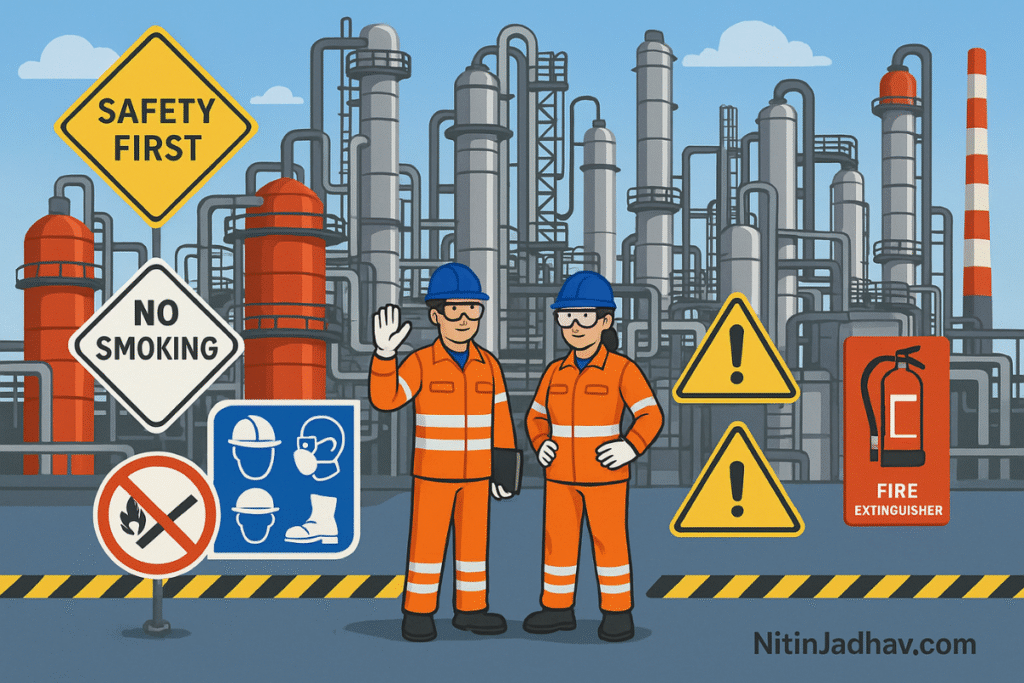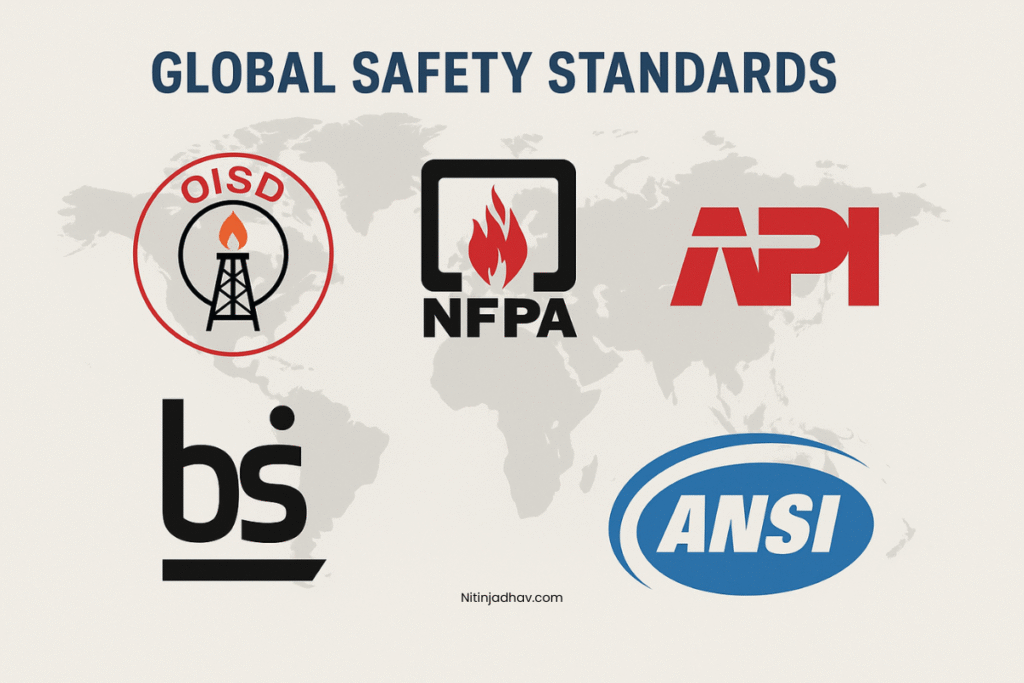Introduction
In high-risk industries like oil & gas, chemicals, and petrochemicals, implementing a robust Health, Safety & Environment Management System (HSEMS) is critical for ensuring the safety of people, protection of property, and preservation of the environment. As the complexity and scale of operations increase, so do the risks. A well-structured HSEMS acts as a proactive tool to manage these risks systematically.
An effective HSEMS provides a formalized framework for setting objectives, assigning responsibilities, defining processes, monitoring performance, and driving continual improvement. It integrates safety management into every aspect of the organization’s operations.
This article presents a comprehensive guide to the structure, principles, implementation, international standards, auditing, and improvement of an HSEMS, especially as practiced in high-hazard industries.
1. What is HSEMS?
HSEMS stands for Health, Safety, and Environment Management System. It is a formalized structure for managing and improving occupational health and safety and environmental performance. It guides organizations in complying with regulations, preventing accidents, reducing environmental footprint, and promoting a culture of safety.
Core Objectives:
- Prevent workplace injuries and illnesses
- Prevent process safety incidents (fires, explosions, releases)
- Ensure regulatory compliance (e.g., OISD, Factories Act, ISO 45001)
- Foster a safety-first organizational culture
- Minimize environmental impacts (air, water, and soil pollution)
- Promote continuous improvement
2. Core Elements of HSEMS
A complete HSEMS consists of several interrelated components that work together to manage risks. The six fundamental pillars are:
2.1 Safety Plan
A safety plan is a strategic document that outlines the organization’s approach to risk management. It reflects leadership commitment and sets direction for HSE activities.
Contents of a Safety Plan:
- Strategic HSE objectives and SMART targets
- Resource allocation (budgets, personnel, tools)
- Performance Indicators (TRIFR, LTIFR, near-miss reporting)
- Annual audit schedules and review timelines
- Legal compliance tracking system
2.2 Policies, Procedures, and Processes
Written documents form the backbone of any HSEMS. Policies express the organization’s commitment. Procedures standardize execution. Processes describe interactions between different functions.
Key Documents Include:
- HSE Policy Statement
- Drug, Alcohol, and Smoking Policy
- Incident Investigation and Reporting Procedure
- Control of Work Procedure (including PTW)
- Energy Isolation (LOTO) Procedure
- Safe Work Practices (SWP)
- Change Management Procedure (MOC)
- Contractor Safety Management Process
2.3 Training and Induction
Training ensures that workers understand their roles, hazards, and safe work practices. Competency development is ongoing and should be based on job hazard profiles.
Key Programs:
- General HSE Induction for new employees
- Job-specific risk-based training (e.g., scaffolding, rigging, hot work)
- HAZOP and PSSR training for engineers
- First aid, fire safety, and evacuation drills
- Refresher training and skill assessments
2.4 Monitoring and Performance Evaluation
Monitoring mechanisms help evaluate the effectiveness of HSE programs. Organizations must track leading and lagging indicators to ensure they are meeting their goals.
Key Monitoring Tools:
- Scheduled safety inspections and audits
- Job safety observations (JSO)
- Equipment integrity checks
- Noise, heat stress, and air quality monitoring
- Digital HSE dashboards and KPIs tracking software
2.5 Supervision
Frontline supervision is vital for translating safety systems into practice. Supervisors act as safety leaders and first responders.
Responsibilities Include:
- Conducting tool-box talks and shift safety briefings
- Identifying unsafe acts/conditions
- Enforcing PPE requirements
- Monitoring confined space entries and critical jobs
- Maintaining logs for safety performance
2.6 Reporting and Communication
Transparent communication enhances accountability and learning. Timely reporting of incidents, near misses, unsafe conditions, and compliance reports is essential.
Common Reporting Formats:
- Near-miss and hazard reporting cards
- Weekly HSE performance summary
- Root Cause Analysis (RCA) and learning bulletins
- Monthly management review reports
- Suggestion schemes and feedback forms
3. Implementation Lifecycle of HSEMS
Step 1: Leadership Commitment
Senior leadership must lead from the front by:
- Setting clear expectations
- Allocating necessary budgets
- Participating in audits and safety reviews
Step 2: Baseline Gap Analysis
Assess the current state of HSE practices and identify gaps using checklists and maturity models.
Step 3: System Design and Documentation
Develop the framework and documentation (manuals, SOPs, risk registers).
Step 4: Training and Awareness
Develop role-based training matrices and deliver awareness sessions for all levels.
Step 5: System Roll-Out
Start implementation with pilot areas or departments and then scale across the facility.
Step 6: Audit, Review, and Improve
Regularly audit the system and update documents based on lessons learned, incident investigations, and performance data.
4. International Standards for HSEMS
- ISO 45001: Occupational Health & Safety Management
- ISO 14001: Environmental Management System
- API RP 75: Safety and Environmental Management Program (SEMP)
- ILO Guidelines on OSH Management Systems
- OISD Standards: Indian regulatory guidelines for oil & gas sector
5. Audit Process for HSEMS
Audits are integral to verifying the effectiveness of HSEMS. They also help identify best practices and areas needing improvement.
Types of Audits:
- Compliance Audit
- Conformance Audit (against ISO/OISD)
- System Audit (against HSEMS framework)
- Behavioural Safety Audit
Audit Checklist Includes:
- Availability of up-to-date HSE policy
- Compliance with legal and regulatory requirements
- Evidence of training and competency verification
- Effectiveness of emergency drills
- Incident investigation closure status
6. Frequent Weaknesses in HSEMS Identified During Audits
- Poor PTW control and documentation
- Incomplete MOC records
- Lack of behavioral safety culture
- Inadequate communication of lessons learned
- Missing fire load calculations and fire safety audits
- Insufficient tracking of leading indicators
7. Best Practices for Sustaining HSEMS
- Establish cross-functional safety committees
- Use mobile HSE apps for inspections and reporting
- Integrate HSE into procurement and project reviews
- Promote Stop Work Authority (SWA) among all staff
- Recognize and reward proactive safety behavior
- Conduct annual 3rd-party HSE audits
8. Internal Resources
- Fire and Gas Detector Mapping
- HAZOP and PHA Studies
- LOPA and SIL Studies
- Safety Audit Process
- Emergency Response and Disaster Management Plan (ERDMP)
9. External Resources
- ISO Official Site for ISO 45001
- International Labour Organization – HSE Guidelines
- API RP 75 Framework
Conclusion
A well-implemented Health, Safety & Environment Management System (HSEMS) acts as a cornerstone of operational integrity and risk management in high-hazard industries. It ensures that safety isn’t a checkbox but a continuous journey of commitment, awareness, and improvement. Organizations that embrace HSEMS as part of their core culture benefit from fewer incidents, higher employee morale, better regulatory compliance, and long-term sustainability.
Remember: Safety isn’t expensive—it’s priceless.
Explore more at the Process Safety section of NitinJadhav.com.


